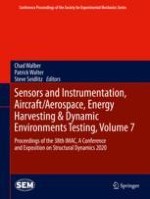2021 | Book
Sensors and Instrumentation, Aircraft/Aerospace, Energy Harvesting & Dynamic Environments Testing, Volume 7
Proceedings of the 38th IMAC, A Conference and Exposition on Structural Dynamics 2020
Editors: Chad Walber, Dr. Patrick Walter, Steve Seidlitz
Publisher: Springer International Publishing
Book Series : Conference Proceedings of the Society for Experimental Mechanics Series
